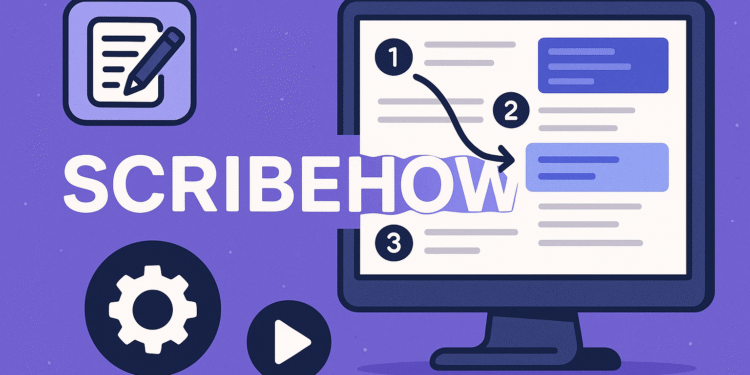Scribehow Training and onboarding have changed dramatically in the last decade. With remote and hybrid work, teams rely heavily on digital tools. This shift has made it harder to deliver clear, consistent, and engaging training. The problem isn’t just complexity—it’s the time spent repeating the same explanations and writing lengthy documents that people rarely read in full.
A New Approach to Process Documentation
ScribeHow offers a refreshingly simple solution. Instead of writing instructions manually, you record yourself doing the task once. As you work, the tool automatically generates a clean, step-by-step guide—complete with screenshots, annotations, and text. The result? A polished resource that’s ready to share within minutes.
How ScribeHow Works in Practice
Using ScribeHow is straightforward. Install the browser extension or desktop app, click “record,” and complete your workflow. The software captures your clicks, keystrokes, and navigation. Once you stop recording, it compiles everything into a visually appealing guide. You can then edit, brand, redact sensitive details, and export the guide in formats like PDF, HTML, or Markdown.
Saving Time While Boosting Productivity
For managers and trainers, the time savings are substantial. What might take an hour to explain verbally can be documented in minutes. Teams report reductions of up to 15x in documentation time, freeing employees to focus on higher-value work. This is especially useful for roles with frequent repetitive questions—ScribeHow turns those answers into reusable resources.
Consistency That Builds Trust
When multiple people train new hires, instructions can vary in tone, detail, and accuracy. ScribeHow eliminates that inconsistency. Every guide follows the same structure, meaning employees receive the same information every time. This consistency helps new team members feel confident and reduces the risk of errors caused by unclear instructions.
Real-World Feedback from Users
Teams using ScribeHow often talk about its ease of adoption. One HR manager shared that new hires preferred ScribeHow guides over traditional manuals because they were shorter, more visual, and easier to follow. Another operations lead said the tool cut onboarding time nearly in half, allowing employees to start contributing sooner.
Use Cases Across Industries
While many think of onboarding as HR’s responsibility, the reality is that every department benefits.
- IT teams document system setup processes.
- Customer support outlines workflows for ticket management.
- Marketing shares brand guidelines and campaign workflows.
- Sales explains CRM data entry and reporting.
Because ScribeHow is adaptable, it fits into almost any workflow without disrupting existing systems.
Keeping Sensitive Information Secure
Some processes involve private information, such as employee data or client records. ScribeHow includes manual and automatic redaction tools to blur sensitive details in screenshots. This makes it safe to share guides without risking confidentiality breaches.
Why It’s a Natural Fit for Onboarding
Onboarding isn’t just about telling new hires what to do—it’s about building confidence. ScribeHow supports this by providing resources employees can revisit anytime. Instead of relying solely on live training sessions, managers can share guides that new hires review at their own pace, reinforcing learning.
Integrating with Existing Tools
The guides you create in ScribeHow aren’t locked into a single platform. They can be shared via a simple link, embedded in an intranet, added to a learning management system, or even dropped into a Slack channel. This flexibility makes it easy to put training materials where employees already spend their time.
Easy to Start, Easy to Scale
One of the reasons teams adopt ScribeHow so quickly is its simplicity. There’s no steep learning curve—most users create their first guide in under ten minutes. Once it’s part of the workflow, it scales effortlessly. Whether you have five employees or five hundred, your library of guides grows over time, creating a lasting resource bank.
Beyond Onboarding: Continuous Learning
Training doesn’t end after the first week. As systems and tools evolve, employees need ongoing learning resources. ScribeHow’s quick editing and updating features mean that documentation stays fresh. Instead of outdated PDFs gathering dust, your team has living resources that reflect current best practices.
Balancing Efficiency with the Human Touch
One risk with automation is losing the personal element of training. ScribeHow avoids this by letting you customize guides with your own tone, brand voice, and examples. The result is documentation that feels like it came from a teammate, not a faceless system.
A Smarter Way to Share Knowledge
At its core, ScribeHow is about capturing what you know in the moment you’re doing it. This approach reduces friction, preserves accuracy, and ensures that valuable knowledge doesn’t stay trapped in one person’s head. It’s a practical tool for modern teams who need speed without sacrificing quality.
Final Thoughts
Training and onboarding will always require a human element, but that doesn’t mean they have to be slow, inconsistent, or repetitive. ScribeHow blends automation with customization, giving teams a way to create training resources that are fast to make, easy to use, and consistent across the board.
For organizations juggling multiple systems, complex processes, and distributed teams, it’s a game-changer. Instead of explaining the same thing over and over, you can focus on higher-level coaching—knowing that your step-by-step guides are already doing the heavy lifting.
FAQ’S
1. What is ScribeHow used for?
ScribeHow is used to quickly create visual, step-by-step guides for any process. It records your actions as you work and turns them into shareable instructions—ideal for training, onboarding, and process documentation.
2. Is ScribeHow easy to learn?
Yes. Most users create their first guide in under ten minutes. The interface is intuitive, so even non-technical team members can use it without training.
3. Can I share ScribeHow guides with anyone?
You can share guides via a link, embed them into your company’s knowledge base, export as PDFs, or post them in team channels like Slack or Microsoft Teams.
4. Does ScribeHow protect sensitive information?
Yes. It includes built-in redaction tools that let you blur or hide sensitive data in screenshots before sharing your guides.









